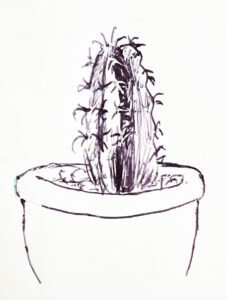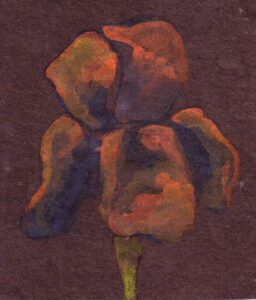KC, Rebecca’s Husband, Discovers He Might Be a Highly Sensitive Person
Last week Rebecca’s husband, KC, said that he’d just come across a quiz that revealed that he was a Highly Sensitive Person (HSP). Rebecca, in what could be easily be called a highly insensitive response, literally laughed out loud and said, “You are not an Highly Sensitive Person!”
KC Is Not An Orchid!
Rebecca was so amused and emphatic because, for anyone who knows KC, the thought of him as an “orchid”, what HSPs are often called, was absurd. He might be more likened to a reed or a shoot of bamboo. Although he is indeed sensitive, he is also hearty, resilient, and flexible.
He Is Apparently Not Even a Flower
Because we are art therapists, we of course asked KC to draw himself as flower but his response reveals that apparently he is actually not even a flower but a cactus–a great visual illustration of his heartiness. In addition, on another very useful personality profile, The Big Five Personality Traits, he scores high on agreeableness, openness, and conscientiousness. And although he is sensitive to environmental factors, his central nervous system does not get overloaded and he does not experience high degrees of pain.

Overgeneralizing What Are Sensitivities
On the other hand, we can understand why he rated as HSP because the quiz does not really differentiate between being aware of one’s surroundings and others from being overstimulated by environmental irritants and triggered by negative encounters. In other words, it designates these all as “sensitivities”.
So characteristics that KC possess–intuition, a rich inner life, social intelligence, and being attuned to his environment—weave in undifferentiated with genuine challenges like being affected by other people’s moods and becoming unpleasantly aroused when a lot is going on.
Counterbalancing with a Resiliency Questionnaire
To supplement the HSP quiz, we suggested KC take a Resilience Questionnaire. Not surprisingly, he scored high in most of the domains—especially adaptability, persistence, and self-sufficiency. These characteristics naturally counterbalance his “sensitivities” and explain why he is not an orchid.
Rebecca and Gioia Also Meet Criteria for HSP
For kicks, Rebecca and Gioia decided to take the questionnaire and both also met the criteria for HSP. Rebecca scored 19, like KC, and Gioia a little bit lower, 17. Again, those you who know Gioia know that although she meets many of the characteristics of an HSP like avoiding upsetting situations, being very affected by other people’s moods, one of her outstanding qualities is her emotional buoyancy. She bounces back really quickly from negative experiences, especially emotional and psychological difficulties.
Rebecca High on Neuroticism and Sensitivity to Pain
Rebecca, on the other hand, scores low on the resilience test in optimism and self-sufficiency. She also tends to meet more of the characteristics in the Big Five model for neuroticism some of which are captured in the HSP questionnaire—reactive to negativity and prone to negative emotions and she tends to have physical sensitivities that makes her nervous system more prone to being overstimulated and overwhelmed.

Being Overly Sensitive As A Child May Be a Good Match for Becoming A Therapist
Interestingly, both Gioia and Rebecca identified with most on the HSP questionnaire having been repeatedly been told as a child that they were overly sensitive. However, they both see clearly that that sensitivity was one of the things led them to becoming therapists.
The image at the top of the post, by the way, is Gioia’s response to “If you were a flower” and to the left here is Rebecca’s flower.
The HSP Model Helps Identity Sensory Overstimulation
Let’s be clear that, although we are poking some holes at the Highly Sensitive Person construct—most especially that it needs to be viewed in the context of resiliencies, strengths, and emotional buoyancy—we also think it identifies one area that is not accounted for by many other questionnaires. It very accurately captures physiological and sensory overstimulation, something which very seriously impacts people.
Sensitivity As a Strength
In addition, it helps identify one of the most outstanding characteristics of HSP—a sensitivity to the nuances and depth of environmental and emotional cues. Although this can be challenging to manage, it also makes HSP highly empathic and observant, qualities which they bring to both their relationships and their work.
This is particularly important at this time when there are very real and heightened environmental stressors not just in this country but in the world–political strife, war, climate changes, disruption in the food chain and access to resources. HSP’s can be particularly attuned to this “activity” (that is a euphemism to say the least!).
How Does One “Treat” or Manage Being Highly Sensitive?
We recommend and use a series of strategies that include but are not limited to:
- Reduce and soothe nervous system reactivity
- Establish and maintaining effective emotional and physical boundaries
- Express emotional responses to negative input
- Increase mindfulness and awareness of responses
- Increase positive emotions
- Reduce reactivity and sensitivity to negative ones
- Identify strengths and resiliencies that have in the past and can continue to counter the sensitivities
- Capitalize on the strengths inherent in the sensitivities
- Look at what is being interpreted about information being intuitively sensed from the environment
- Challenge limiting interpretations of environmental cues
- Identify and engage empowering actions that give you a sense of agency and accomplishment
Here are links to the HSP and the Other Personality Profiles We Have Mentioned
FYI, thankfully these are are all free:
- The Highly Sensitive Person Questionnaire
- Resilience Quiz
- The Big Five Factor Personality Test
- The Values In Action Strengths Survey (VIA)
With sensitivity and regard, Rebecca and Gioia
Art Directive
Take the Highly Sensitive questionnaire and at least one of the other questionnaires we listed (we recommend first the Resilience one).
Then make a picture of yourself as a flower. What does your flower tell you about both your sensitivities and your resiliencies?
Because artwork communicates so well, if you want input on the personality of your “flower”, you can always ask someone you trust to intuitively respond to it. They will often have useful insights.
You can also always contact us for some help in understanding what it says. More importantly if you really feel like you are challenged with the negative attributes of an HSP, you can always reach out to us for support.
